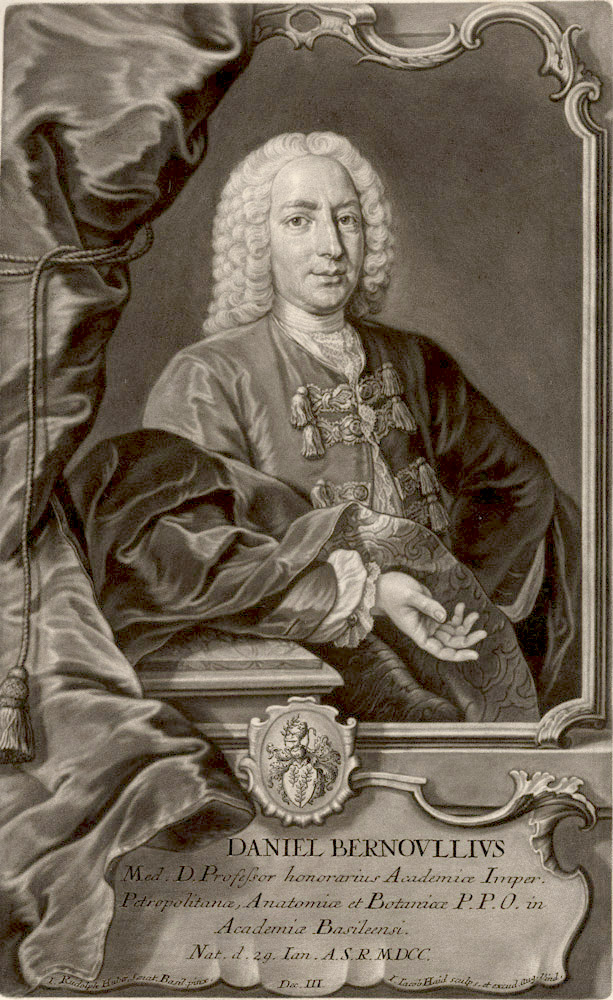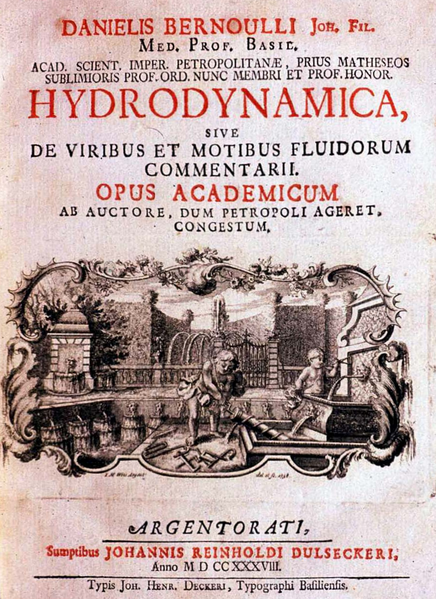
Daniel Bernoulli (1700-1782)
On February 8, 1700, (January 29, according to the then valid Julian calendar), Swiss mathematician and physicist Daniel Bernoulli was born. Being one of the many prominent mathematicians in the Bernoulli family, Daniel Bernoulli is particularly remembered for his applications of mathematics to mechanics, especially fluid mechanics, and for his pioneering work in probability and statistics. His name is commemorated in the Bernoulli principle, a particular example of the conservation of energy, which describes the mathematics of the mechanism underlying the operation of two important technologies of the 20th century: the carburetor and the airplane wing.
“Nature always tempts to act in the most simplest way.” (Daniel Bernoulli)
Daniel Bernoulli – Early Years
Daniel Bernoulli was born in Groningen, in the Netherlands, into a family of distinguished mathematicians, which originally came from Antwerp, at that time in the Spanish Netherlands, but emigrated to escape the Spanish persecution of the Huguenots. Daniel had two brothers, the older Nicolaus (II) Bernoulli and his younger brother Johann (II) Bernoulli. When Daniel was five years old the family returned to their native city of Basel where Daniel’s father Johann Bernoulli, one of the early developers of calculus, filled the chair of mathematics left vacant on the death of his uncle Jacob Bernoulli,[1] who was the first to discover the theory of probability.[1] All three sons of Johann Bernoulli would go on to study mathematics but this was not the course that his father had planned for Daniel.
Poor Rewards Awaiting a Mathematician
Around schooling age, his father, Johann, encouraged him to study business, there being poor rewards awaiting a mathematician. However, Daniel refused, because he wanted to study mathematics. He later gave in to his father’s wish and studied business. His father then asked him to study in medicine, and Daniel agreed under the condition that his father would teach him mathematics privately, which they continued for some time. This Daniel did spending time studying medicine at Heidelberg in 1718 and Strasbourg in 1719. He returned to Basel in 1720 to complete his doctorate in medicine with a dissertation on the mechanics of breathing in 1721.[2]
“All birds need to fly are right-shaped wings, the right pressure, and the right angle.” (Daniel Bernoulli)
Mathematical Exercises
Daniel wanted to embark on an academic career like his father so he applied for two chairs at Basel. Unfortunately the final decision for both positions was decided by a drawing of lots, and both times Daniel failed to win this game of chance. Daniel then decided to continue his studies with practical medicine in Padua. On his way he got stuck in Venice due to illness and by that time in 1724 he was able to publish his earliest mathematical work, the Exercitationes quaedam Mathematicae (Mathematical Exercises), with the help of Russian mathematician Christian Goldbach.[8] The first part described the game of faro and is of little importance other than showing that Daniel was learning about probability at this time. The second part was on the flow of water from a hole in a container and discussed Newton’s theories (which were incorrect).
Collaboration with Euler
“I thought we should require physical determinations, and not abstract integrations. A pernicious taste begins to infiltrate, from which real science will suffer far more than it will progress, and it would be often better for the true physics if there were no mathematics in the world.”
– Daniel Bernoulli, Letter to Leonhard Euler, 26 January 1750
Having attained academic fame with his Exercitationes, Daniel Bernoulli was invited to take up the chair of mathematics at St Petersburg. His brother Nicolaus (II) Bernoulli was also offered a chair of mathematics at St Petersburg so in late 1725 the two brothers travelled to St Petersburg. Within eight months of their taking up the appointments in St Petersburg Daniel’s brother died of fever. Daniel was left, greatly saddened at the loss of his brother and also very unhappy with the harsh climate.[2] It was in 1727 that Leonard Euler arrived in St. Petersburg, when Daniel Bernoulli’s most productive time in his life should begin.[5] Together Bernoulli and Euler tried to discover more about the flow of fluids. In particular, they wanted to know about the relationship between the speed at which blood flows and its pressure. To investigate this, Daniel experimented by puncturing the wall of a pipe with a small open ended straw and noted that the height to which the fluid rose up the straw was related to fluid’s pressure in the pipe.
Harmonic Vibrations and Political Economy
Daniel Bernoulli showed that the movements of strings of musical instruments are composed of an infinite number of harmonic vibrations all superimposed on the string. Another important work produced while in St Petersburg was one on probability and political economy. Daniel makes the assumption that the moral value of the increase in a person’s wealth is inversely proportional to the amount of that wealth. He then assigns probabilities to the various means that a person has to make money and deduces an expectation of increase in moral expectation. Daniel applied some of his deductions to insurance.[2]

Frontpage of Daniel Bernoulli’s ‘Hydrodynamica’ (1738)
Fluid Flows
Daniel Bernoulli’s reputation was established in 1738 with Hydrodynamica, in which he considered the properties of basic importance in fluid flow, particularly pressure, density, and velocity, and set forth their fundamental relationship. The work resembles Joseph Louis Lagrange‘s Mécanique Analytique in being arranged so that all the results are consequences of a single principle, namely, conservation of energy. Daniel also discussed pumps and other machines to raise water. He put forward what is called Bernoulli’s principle, which states that the pressure in a fluid decreases as its velocity increases. He also established the basis for the kinetic theory of gases and heat by demonstrating that the impact of molecules on a surface would explain pressure and that, assuming the constant, random motion of molecules, pressure and motion increase with temperature. About 1738 his father Johann Bernoulli published Hydraulica; this attempt by Johann to obtain priority for himself was another instance of his antagonism toward his son.[3]
Plagiarism and a Difficult Father Son Relation
Daniel Bernoulli is said to have had a bad relationship with his father. Upon both of them entering and tying for first place in a scientific contest at the University of Paris, Johann, unable to bear the “shame” of being compared as Daniel’s equal, banned Daniel from his house. Johann Bernoulli also plagiarized some key ideas from Daniel’s book Hydrodynamica in his own book Hydraulica which he backdated to before Hydrodynamica. Despite Daniel’s attempts at reconciliation, his father carried the grudge until his death.
Back in Basel
Daniel Bernoulli returned to the University of Basel, where he first held the chair of medicine, but botany lectures were not what Daniel wanted and things became better for him in 1743 when he was able to exchange these for physiology lectures. In 1750, however, he was appointed to the chair of physics and taught physics at Basel for 26 years until 1776. In May, 1750 he was elected a Fellow of the Royal Society.
Awards and Honours
Between 1725 and 1749 Bernoulli won or shared 10 Grand prizes of the Paris Academy of Sciences, for topics in astronomy and nautical topics, a feat equaled by only one other person, his friend and rival Leonhard Euler. He won in 1740 (jointly with Euler) for work on Newton’s theory of the tides; in 1743 and 1746 for essays on magnetism; in 1747 for a method to determine time at sea; in 1751 for an essay on ocean currents; in 1753 for the effects of forces on ships; and in 1757 for proposals to reduce the pitching and tossing of a ship in high seas.[2] Because of a difference of opinion with Euler, Bernoulli became interested in sound phenomena and discovered that a closed organ pipe can produce only odd harmonics and that pressure determines the relative amplitudes of the harmonics.
Daniel Bernoulli’s last work involved the application of probability theory to various practical matters, such as inoculation and relative proportion of male and female births. He died in Basel on March 17, 1782, at age 82.[4] Daniel Bernoulli was buried after his death in the church of St.Peter in Basel.
Ramamurti Shankar, 20. Fluid Dynamics and Statics and Bernoulli’s Equation, [15]
References and further Reading:
- [1] How to Calculate Fortune – Jakob Bernoulli, SciHi blog, August 16, 2012.
- [2] O’Connor, John J.; Robertson, Edmund F., “Daniel Bernoulli“, MacTutor History of Mathematics archive, University of St Andrews.
- [3] Daniel Bernoulli, Swiss mathematician, at Britannica Online
- [4] Daniel Bernoulli Facts at Your Dictionary
- [5] Read Euler, he is the Master of us all…, SciHi blog, September 18, 2015.
- [6] Daniel Bernoulli at zbMATH
- [7] Daniel Bernoulli at Wikidata
- [8] Although I Cannot Prove it… – The Famous Goldbach Conjecture, SciHi Blog
- [9] Works by or about Daniel Bernoulli at Internet Archive
- [10] Weisstein, Eric Wolfgang (ed.). “Bernoulli, Daniel (1700–1782)”. ScienceWorld.
- [11] Rothbard, Murray. Daniel Bernoulli and the Founding of Mathematical Economics, Mises Institute
- [12] Daniel Bernoulli at Wikidata
- [13] Daniel Bernoulli at zbMATH
- [14] Daniel Bernoulli at Mathematics Genealogy Project
- [15] Ramamurti Shankar, 20. Fluid Dynamics and Statics and Bernoulli’s Equation, Yale Courses @ youtube
- [16] Timeline of the Bernoulli family, via DBpedia and Wikidata






Pingback: Whewell’s Gazette Year 2, Vol. #31 | Whewell's Ghost
Pingback: Whewell’s Gazette: Year 3, Vol. #31 | Whewell's Ghost